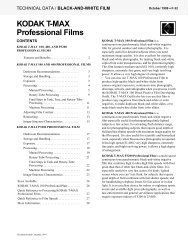Downloaded - Kodak
Downloaded - Kodak
Downloaded - Kodak
You also want an ePaper? Increase the reach of your titles
YUMPU automatically turns print PDFs into web optimized ePapers that Google loves.
Yellow Developer Solution<br />
Processing Cycle<br />
In the yellow developer solution, a positive silver image is formed in the blue-sensitive layer by the<br />
action of the color developing agent on the silver halide that was exposed during the blue printing<br />
operation. Simultaneously, a positive yellow dye image is formed by the reaction between the oxidized<br />
color developing agent and the yellow coupler. See the section, "Cyan Developer Solution" for the<br />
generic equations.<br />
During the yellow development step, the blue-sensitive layer must be developed to completion while<br />
unwanted yellow development (fogging) of the green-sensitive layer is kept to a minimum. Any<br />
undeveloped silver halide in the blue-sensitive layer is developed in the magenta developer solution,<br />
causing magenta dye contamination in the yellow layer. Conversely, fogging of the green-sensitive<br />
layer during yellow development causes yellow dye contamination in the magenta layer and a<br />
significant reduction in the magenta dye yield. A normal process K-14M yellow developer solution<br />
provides the required yellow and magenta separation.<br />
Normally, all of the exposed silver halide in the red-sensitive layer is developed in either the first or the<br />
cyan developer solution. If any exposed silver halide in this layer remains undeveloped after the cyan<br />
developer solution, it is developed in the yellow developer solution, and results in yellow dye<br />
contamination in the cyan layer.<br />
Yellow Developer Wash<br />
This wash stops the yellow development and removes the yellow developer solution from the film.<br />
Magenta Developer Solution<br />
At this stage in the processing sequence, only the green-sensitive layer should contain any unexposed<br />
silver halide. Therefore, selective reexposure is unnecessary. The reversal agent in the magenta<br />
developer solution nucleates (chemically reexposes) all the remaining silver halide.<br />
During magenta development, a positive silver image is formed in the green-sensitive layer by the<br />
action of the color developing agent on the silver halide. Simultaneously, a positive magenta dye image<br />
is formed by the reaction of the oxidized color developing agent with the magenta coupler. See the<br />
section, "Cyan Developer Solution" on the previous page.<br />
Magenta development is somewhat less critical than cyan and yellow development, because if the<br />
preceding steps were properly carried out, no silver halide should remain in the red- and blue-sensitive<br />
layers. Therefore, no unwanted magenta dye development should occur. However, if any silver halide<br />
is present in the red- or blue-sensitive layers, it is nucleated and developed in the magenta developer<br />
solution, producing magenta dye contamination of the cyan or yellow dye image.<br />
The silver halide in the green-sensitive layer is the most difficult to develop completely, and incomplete<br />
development results in an inadequate magenta dye image, especially in the maximum-density areas.<br />
Magenta Developer Wash<br />
Conditioner<br />
This wash removes the magenta developer solution from the film. This is the most critical of all the<br />
wash steps because it is more difficult to remove the components of the magenta developer solution.<br />
The conditioner prepares the metallic silver developed in the first and color developers for oxidation to<br />
silver halide in the bleach step. It helps preserve the acidity of the bleach solution by reducing carryover<br />
of magenta developer into the bleach. An oxidized conditioner solution is ineffective and may cause<br />
silver to be retained in processed film.<br />
TG2044-1 – 06APR99 29
















